The ARM vs x86 Wars Have Begun: In-Depth Power Analysis of Atom, Krait & Cortex A15
by Anand Lal Shimpi on January 4, 2013 7:32 AM EST- Posted in
- Tablets
- Intel
- Samsung
- Arm
- Cortex A15
- Smartphones
- Mobile
- SoCs
SunSpider 0.9.1
The results get more interesting when we look at power consumption during active workloads. We'll start off with SunSpider, a mid-length JavaScript benchmark that we frequently use in our reviews:
At the platform level, Qualcomm's APQ8060 powered Dell XPS 10 falls in between Surface RT and Acer's W510. Active power looks very similar to the Intel powered W510, but performance is appreciably slower so total energy consumed is higher.
Looking at the CPU, the situation changes a bit. Intel's peak power consumption is similar to Tegra 3, while Krait manages to come in appreciably lower. I suspect that missing the L2 cache power island here is lowering Qualcomm's power consumption by 100 - 200mW but overall CPU-only power consumption would still be lower. Once again, at idle Krait seems to have a bit of an advantage as well.
The situation changes once we look at GPU power consumption, with Intel/Imagination having the clear advantage here.

Kraken
Mozilla's Kraken benchmark is a new addition to our js performance suite, and it's a beast. The test runs for much longer than SunSpider, but largely tells a similar story:
At the platform level, Acer's W510 has slightly higher peak power consumption compared to the Dell XPS 10 but it also completes the test quicker, giving it a better overall energy usage profile.
Looking at the CPU cores themselves, Qualcomm holds onto its lead here although once again, I suspect the margin of victory is exaggerated by the fact that we're not taking into account L2 power consumption for Qualcomm. Intel does deliver better performance, which allows the CPU to race to sleep quicker than on APQ8060A.
The comparison to Tegra 3 is not surprising, this is exactly what we've seen play out in our battery life tests as well.
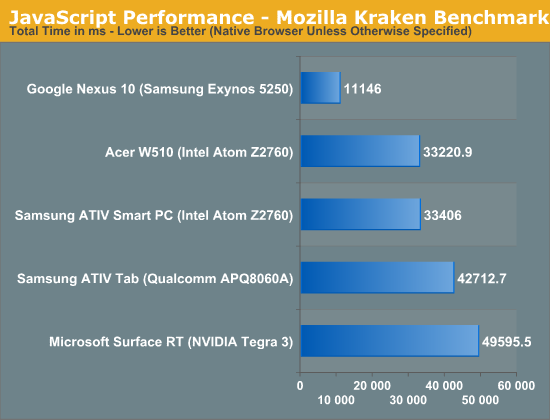
RIABench
RIABench's Focus Tests are on the other end of the spectrum, and take a matter of seconds to complete. What we get in turn is a more granular look at power consumption:
Here the W510 consumes more power at the platform level, but drops to a lower idle state than the XPS 10. Surface RT clearly uses more power than both.
Krait's CPU level (excluding L2 cache) power consumption is once again lower than Atom's, but Atom completes the task quicker. In this case total energy usage is still in Qualcomm's favor. The fact that there's a discrepancy between CPU specific power results and the total platform results are partly due to the missing L2 cache power consumption data from the CPU power chart for Qualcomm, and partly due to differences in the tablets themselves.
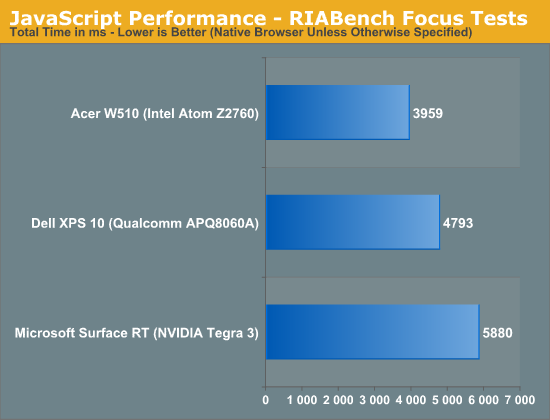


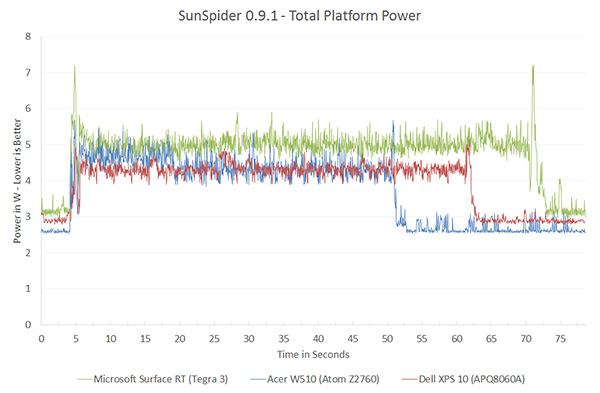


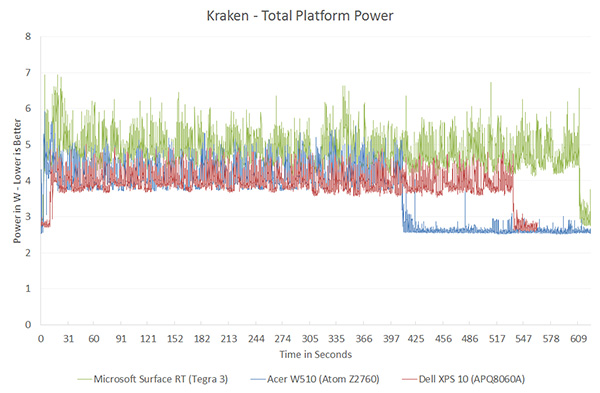
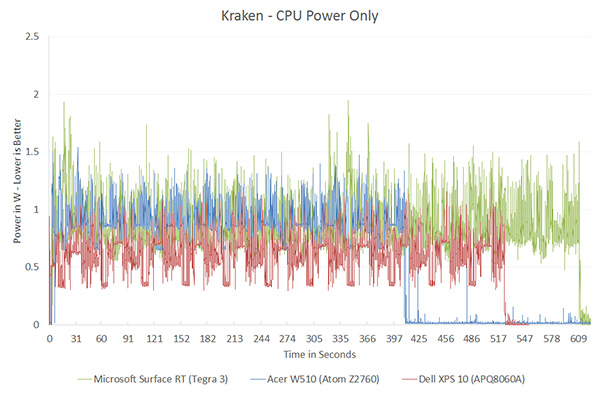
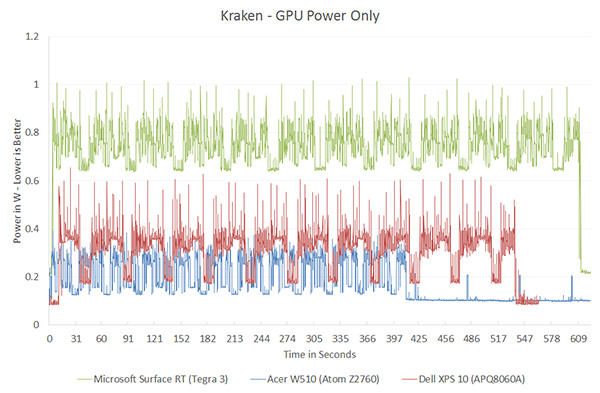
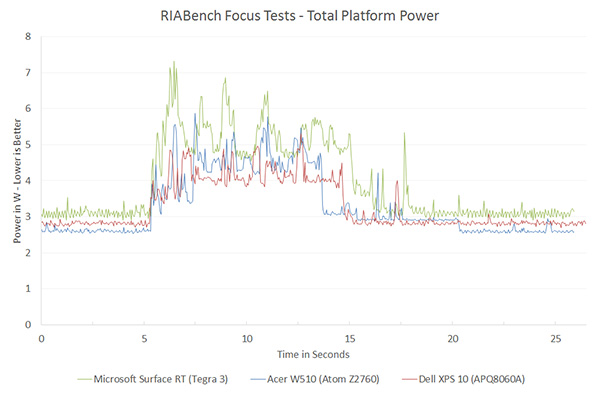
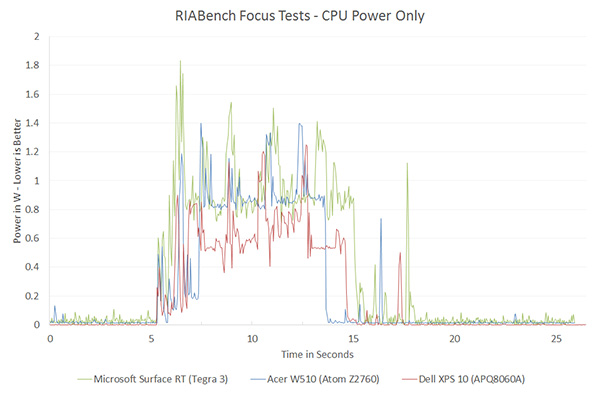
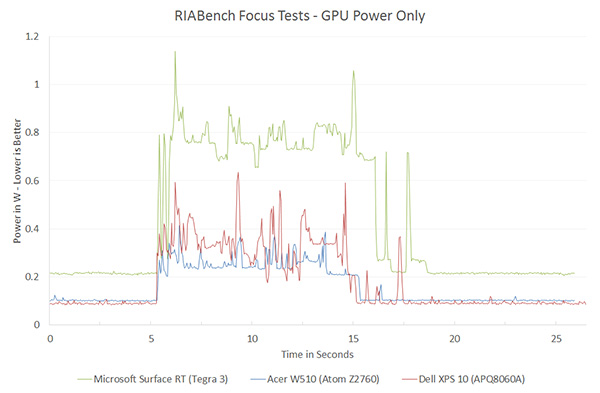








140 Comments
View All Comments
metafor - Friday, January 4, 2013 - link
It matters to a degree. Look at the CPU power chart, the CPU is constantly being ramped from low to high frequencies and back.Tegra automatically switches the CPU to a low-leakage core at some frequency threshold. This helps in almost all situations except for workloads that constantly keep the CPU at above that threshold, which, if you look at the graph, isn't the case.
That being said, that doesn't mean it'll be anywhere near enough to catch up to its Atom and Krait competitors.
jeffkro - Saturday, January 5, 2013 - link
The tegra 3 is also not the post powerful arm processor, intel obviously chose it to make atom look better.npoe1 - Wednesday, January 9, 2013 - link
From one of Ananad's articles: "NVIDIA recently revealed it was doing something similar to this with its upcoming Tegra 3 (Kal-El) SoC. NVIDIA outfitted its next-generation SoC with five CPU cores, although only a maximum of four are visible to the OS. If you’re running light tasks (background checking for email, SMS/MMS, twitter updates while your phone is locked) then a single low power Cortex A9 core services those needs while the higher performance A9s remain power gated. Request more of the OS (e.g. unlock your phone and load a webpage) and the low power A9 goes to sleep and the 4 high performance cores wake up."http://www.anandtech.com/show/4991/arms-cortex-a7-...
jeffkro - Saturday, January 5, 2013 - link
A15 currently pulls to much power for smartphone but it makes for a great tablet chip as well as providing enough horse power to power basic laptops.djgandy - Friday, January 4, 2013 - link
The most obvious thing here is that PowerVR graphics are far superior to Nvidia graphics.Wolfpup - Friday, January 4, 2013 - link
Actually no, that isn't obvious at all. Tegra 3 is a two year old design, on a 2 generations old process. The fact that it's still competitive today is just because it was so good to begin with. It'll be nessisary to look at the performance and power usage of upcoming Nvidia chips on the same process to actually say anything "obvious" about them.Death666Angel - Friday, January 4, 2013 - link
According to Wikipedia, the 545 is from January '10, so it's got its a 3 year old now. The only current gen thing here is the Mali. The 225 is just a 220 with a higher clock, so it's about 1.5 to 2 years old.djgandy - Friday, January 4, 2013 - link
And a 4/5 year old atom and the 2/3 year+ old SGX545 aren't old designs?Look at the power usage of Nvidia. It's way beyond what is acceptable for any SOC design. Phones from 2 years ago used far less power on older processes than the 40nm T3! Just look at GLbenchmark battery life tests for the HTC One X and you'll see how poor the T3 GPU is. In fact just take your Nvidia goggles off and re-read this whole article.
Wolfpup - Friday, January 4, 2013 - link
Atom's basic design is old, the manufacturing process is newer. Tegra 3 is by default at the biggest disadvantage here. You accuse me of bias when it appears you're actually biased.Chloiber - Tuesday, January 8, 2013 - link
First of all it's still 40nm.Second of all: you mentioned the battery benchmarks yourself. Go look at the Nexus 4 review and look how the international version of the One X fares. Battery life on the T3 One X is very good, if you take into account that it's based on 40nm compared to 28nm of the One XL and uses 4 cores.